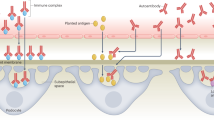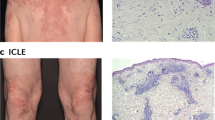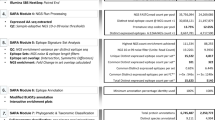Abstract
Transmissibility of characteristic lesions to experimental animals may help us understand the pathomechanism of human autoimmune disease. Here we show that human autoimmune disease can be reproduced using genetically engineered model mice. Bullous pemphigoid (BP) is the most common serious autoimmune blistering skin disease, with a considerable body of indirect evidence indicating that the underlying autoantigen is collagen XVII (COL17). Passive transfer of human BP autoantibodies into mice does not induce skin lesions, probably because of differences between humans and mice in the amino acid sequence of the COL17 pathogenic epitope. We injected human BP autoantibody into Col17-knockout mice rescued by the human ortholog. This resulted in BP-like skin lesions and a human disease phenotype. Humanization of autoantigens is a new approach to the study of human autoimmune diseases.
This is a preview of subscription content, access via your institution
Access options
Subscribe to this journal
Receive 12 print issues and online access
$209.00 per year
only $17.42 per issue
Buy this article
- Purchase on Springer Link
- Instant access to full article PDF
Prices may be subject to local taxes which are calculated during checkout



Similar content being viewed by others
References
Jacobson, D.L., Gange, S.J., Rose, N.R. & Graham, N.M.H. Epidemiology and estimated population burden of selected autoimmune diseases in the United States. Clin. Immunol. Immunopathol. 84, 223–243 (1997).
Taneja, V. & David, C.S. Lessons from animal models for human autoimmune diseases. Nat. Immunol. 2, 781–784 (2001).
Gregersen, J.W., Holmes, S. & Fugger, L. Humanized animal models for autoimmune diseases. Tissue Antigens 63, 383–394 (2004).
Anhalt, G.J., Labib, R.S., Voorhees, J.J., Beals, T.F. & Diaz, L.A. Induction of pemphigus in neonatal mice by passive transfer of IgG from patients with the disease. N. Engl. J. Med. 306, 1189–1196 (1982).
Roscoe, J.T. et al. Brazilian pemphigus foliaceus autoantibodies are pathogenic to BALB/c mice by passive transfer. J. Invest. Dermatol. 85, 538–541 (1985).
Madsen, L.S. et al. A humanized model for multiple sclerosis using HLA-DR2 and T-cell receptor. Nat. Genet. 23, 343–347 (1999).
Wen, L. et al. In vivo evidence for the contribution of human histocompatibility leukocyte antigen (HLA)-DQ molecules to the development of diabetes. J. Exp. Med. 191, 97–104 (2000).
Anhalt, G.J. et al. Pathogenic effects of bullous pemphigoid autoantibodies on rabbit corneal epithelium. J. Clin. Invest. 68, 1097–1101 (1981).
Liu, Z. et al. A passive transfer model of the organ-specific autoimmune disease, bullous pemphigoid, using antibodies generated against the hemidesmosomal antigen, BP180. J. Clin. Invest. 92, 2480–2488 (1993).
Zillikens, D. et al. Tight clustering of extracellular BP180 epitopes recognized by bullous pemphigoid autoantibodies. J. Invest. Dermatol. 109, 573–579 (1997).
McGrath, J.A. et al. Mutations in the 180-kD bullous pemphigoid antigen (BPAG2), a hemidesmosomal transmembrane collagen (COL17A1), in generalized atrophic benign epidermolysis bullosa. Nat. Genet. 11, 83–86 (1995).
Gatalica, B. et al. Cloning of the human type XVII collagen gene (COL17A1), and detection of novel mutations in generalized atrophic benign epidermolysis bullosa. Am. J. Hum. Genet. 60, 352–365 (1997).
Shimizu, H. et al. The 97 kDa linear IgA bullous dermatosis antigen is not expressed in a patient with generalized atrophic benign epidermolysis bullosa with a novel homozygous G258X mutation in COL17A1. J. Invest. Dermatol. 111, 887–892 (1998).
Ishiko, A. et al. Human autoantibodies against the 230-kD bullous pemphigoid antigen (BPAG1) bind only to the intracellular domain of the hemidesmosome, whereas those against the 180-kD bullous pemphigoid antigen (BPAG2) bind along the plasma membrane of the hemidesmosome in normal human and swine skin. J. Clin. Invest. 91, 1608–1615 (1993).
Zillikens, D. et al. Antibodies to desmogleins 1 and 3, but not to BP180, induce blisters in human skin grafted onto SCID mice. J. Pathol. 193, 117–124 (2001).
Franzke, C.W., Bruckner, P. & Bruckner-Tuderman, L. Collagenous transmembrane proteins: recent insights into biology and pathology. J. Biol. Chem. 280, 4005–4008 (2005).
Laczko, I. et al. Conformational consequences of coupling bullous pemphigoid antigen peptides to glutathione-S-transferase and their diagnostic significance. J. Pept. Sci. 6, 378–386 (2000).
Acknowledgements
We thank M. Sato, A. Honda, A. Nagasaki and E. Nishizono for technical assistance. This work was supported in part by Grants-in-Aid for Scientific Research from the Japan Society for the Promotion of Science (15390336, 17209038 and 18013002 to H.S.; 17659331, 18390309 and 18659315 to D.S.); by the Project for Realization of Regenerative Medicine from the Ministry of Education, Science, Sports and Culture of Japan (2003–2007 to H.S.); by a grant from the US National Institutes of Health (RO1 AR048982 to K.B.Y.); by a grant from Nu Skin Japan; and by Health and Labour Sciences Research Grants from the Ministry of Health, Labour and Welfare of Japan (2004–2006 to H.S.)
Author information
Authors and Affiliations
Corresponding author
Ethics declarations
Competing interests
The authors declare no competing financial interests.
Supplementary information
Supplementary Fig. 1
Growth and Kaplan-Meier survival curves of wild-type, COL17m− /−, and rescued COL17-humanized mice. (PDF 222 kb)
Rights and permissions
About this article
Cite this article
Nishie, W., Sawamura, D., Goto, M. et al. Humanization of autoantigen. Nat Med 13, 378–383 (2007). https://doi.org/10.1038/nm1496
Received:
Accepted:
Published:
Issue Date:
DOI: https://doi.org/10.1038/nm1496
This article is cited by
-
Collagen XVII deficiency alters epidermal patterning
Laboratory Investigation (2022)
-
Reduced expression of Collagen 17A1 in naturally aged, photoaged, and UV-irradiated human skin in vivo: Potential links to epidermal aging
Journal of Cell Communication and Signaling (2022)
-
Granzyme B inhibition reduces disease severity in autoimmune blistering diseases
Nature Communications (2021)
-
Obesity accelerates hair thinning by stem cell-centric converging mechanisms
Nature (2021)
-
Visualization of autoantibodies and neutrophils in vivo identifies novel checkpoints in autoantibody-induced tissue injury
Scientific Reports (2020)



